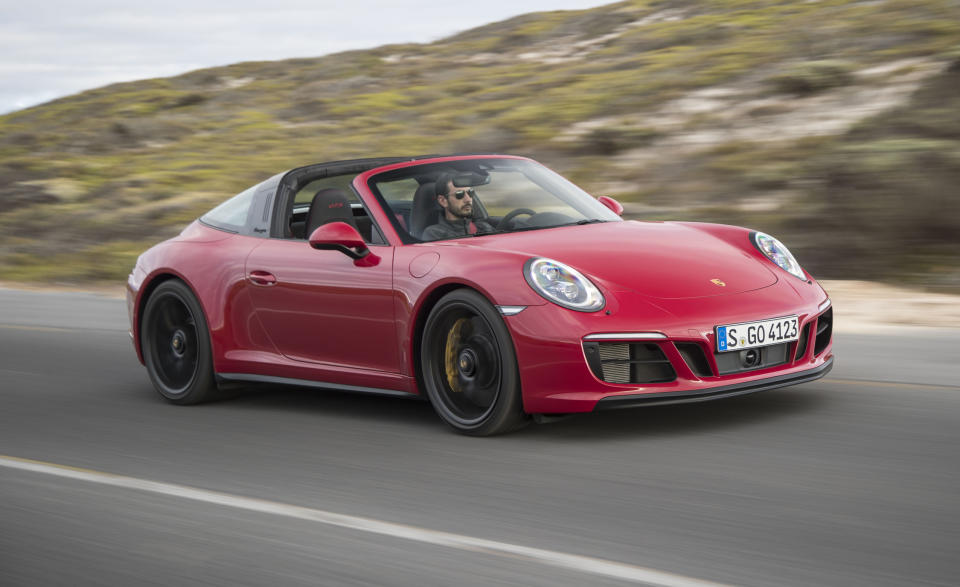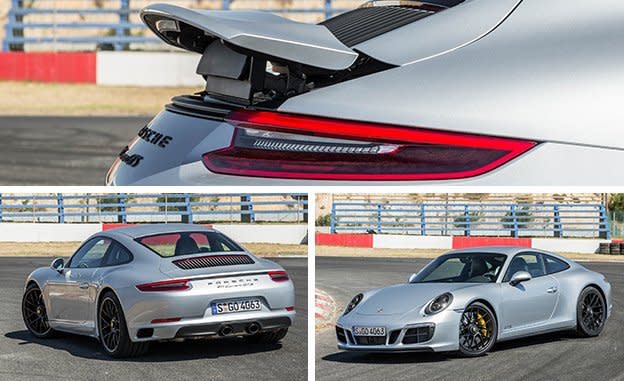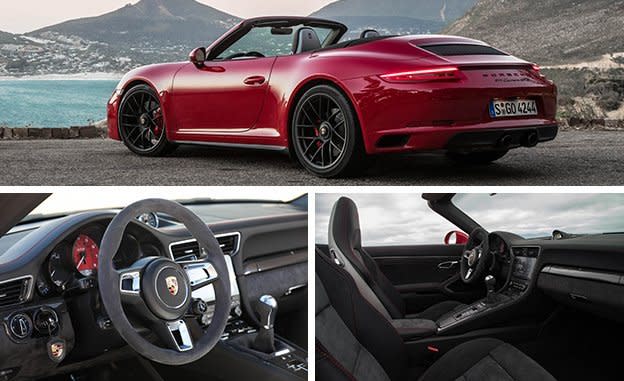2017 Porsche 911 GTS

Porsche has perfected the art of scheduling the launch of new variants of its 911 range to keep something fresh and new in the lineup throughout a model generation. Case in point: this 2017 911 GTS model of the platform launched in its initial 991 form at the 2011 Frankfurt auto show and then updated to 991.2 specs in 2015. One and a half years later, the newest GTS appears—eagerly awaited because it has been one of our favorite models in its previous iterations. It marks the most powerful 911 outside of the monstrously powerful Turbo models and the thinly disguised racer that is the GT3.
Moreover, the GTS has traditionally represented fairly good value—inasmuch as something that crests six figures can, anyway. While the entry-level, 370-hp Carrera comes in at $90,450 and the 420-hp Carrera S commands $104,450, the GTS packs 450 horsepower and is priced at $120,050. Hardly cheap, but the next rung up the ladder is a big leap away: the 540-hp Turbo, at $160,250.
The power of the three Carreras is extracted from the same basic twin-turbocharged flat-six that is mated to a seven-speed manual transmission or the seven-speed dual-clutch automatic called Porsche-Doppelkupplungsgetriebe, or more simply PDK, by the marketing department.

More Punch, Right Now
The additional 30 well-fed horses are easily felt from behind the wheel of this emotion-inspiring 911—and heard, too, since the GTS comes standard with a goodie that needs to be ordered separately on the lesser Carreras: The centrally mounted sport exhaust system, capable of emitting and amplifying an impressive range of engine noises. Porsche says the sprint from zero to 60 mph takes 3.9 seconds with the manual gearbox and just 3.5 seconds with the PDK. Subtract another 0.1 second with the extra-cost all-wheel-drive system, which adds 155 pounds but helps put the torque to the ground with a minimum of wheelspin and corrective action by the traction-control system. Given that we’ve seen the base Carrera with PDK run to 60 mph in 3.4 seconds, it’s safe to say Porsche’s estimates are conservative. The rear-wheel-drive GTS with manual is the fastest Carrera, according to Porsche, topping out at a sweet 194 mph.
The twin-turbo flat-six is so quick to respond that it’s virtually impossible to tell that you’re not flogging a naturally aspirated engine. It’s a high-revving engine, with maximum power at 6500 rpm, and turbocharging brings maximum torque to a lofty 405 lb-ft. We still love the linearity and turbo-free feelings of the 3.8-liter flat-six, but it is essentially impossible to find fault with the new powerplant. What’s more, it is rather efficient for something this quick. Fitted with the manual transmission, it gets 18 mpg in the city and 26 mpg on the highway, and the PDK raises the city figure to an even more commendable 20 mpg.

Shift for Yourself—or Don’t
It’s tough to choose between transmissions, both of which are supplied by ZF. The PDK commands a $3720 premium and brings a weight penalty of 44 pounds, two clear downsides to what Porsche believes is the future of gear selection. On the upside, it can shift gears in an instant, and in Sport Plus mode, the speed and ferocity with which it swaps cogs provides a proverbial kick in the posterior. Aided by the effective launch-control system, it’s no wonder the PDK-equipped car outaccelerates the manual version by a wide margin. The seven-speed stick may not be the ultimate example of a Porsche manual gearbox, but the company has taken some measures to improve on it. Its former unfortunate tendency to guide the driver into fourth gear when downshifting from seventh has been alleviated, and the ’box feels altogether crisper than before. If it were our names on the GTS order sheet, we’d go for the manual, even as we’d wish that Porsche would fit the sweeter-shifting six-speed manual it once offered and recently brought out of mothballs for the limited-edition 911 R, an exotic model that immediately sold out.
One key 911 attribute that appeals to the faithful is the distinctive manner in which the car puts its power to the asphalt: with unmatched immediacy and laserlike precision. It may sound like a cliché, but there may be no other car that feels this close to being an extension of the driver’s own body. (If there is another, it’s the Mazda MX-5 Miata.) We are happy to report that the sensation has not diminished, despite the switch to turbocharging.

Porsche’s brake-based torque-vectoring system is standard on the GTS, and it feels more natural and less aggressive than those that some competitors use, such as the Audi R8. It also has a locking rear differential (mechanical with the standard gearbox, electronically controlled with the PDK) and a lower ride height and a wider track than the Carrera S, plus a high-performance braking system lifted straight from the 911 Turbo. Even the rear-wheel-drive versions have the wide body of the Carrera 4. The Sport Chrono package and its launch-control function is standard, and, for the ultimate in lateral dynamics and stability, you can spec dynamic anti-roll bars and rear-wheel steering.
The GTS encourages you to control its vector with your right foot, but it won’t lash out if you do so in a clumsy manner. For a high-performance sports car, it’s remarkably attitude-free. It’s a great daily driver, with good visibility, a relatively upright seating position, supportive buckets good for long-distance travel, and an easy-to-use cockpit with its controls arranged logically. The sea of buttons on the dash and center console are starting to look a bit dated, and the next generation will surely follow the example of the latest Panamera, with large touch-sensitive screens and a more modern layout.

Many Choices, None Bad
The rear-drive Carrera GTS comes as either a coupe or a convertible. The all-wheel-drive version is also available as a Targa with a retro-themed central roll bar and an almost unbelievable weight penalty: 143 pounds more than the all-wheel-drive coupe and 44 pounds heavier than the cabriolet. It’s the only Targa with a standard black roll bar (GTS buyers can switch back to the brushed metal look if they prefer, while the black finish will be offered on other Targas), and, as with the other Carrera 4 models, its taillights span the entire width of the car.
As for which is the best GTS, that comes down to a matter of taste. After extensive time behind the wheel of every variant, we can assure you that each one delivers a driving experience among the greatest available anywhere.
Specifications >
VEHICLE TYPE: rear-engine, rear- or all-wheel-drive, 2+2 passenger, 2-door coupe, convertible, or targa
BASE PRICE: Carrera GTS, $120,050;
Carrera 4 GTS, $126,950;
Carrera GTS Cabriolet, $132,350;
Carrera 4 GTS Cabriolet, $139,250;
Targa 4 GTS, $139,250
ENGINE TYPE: twin-turbocharged and intercooled DOHC 24-valve flat-6, aluminum block and heads, direct fuel injection
Displacement: 182 cu in, 2981 cc
Power: 450 hp @ 6500 rpm
Torque: 405 lb-ft @ 2150 rpm
TRANSMISSIONS: 7-speed manual, 7-speed dual-clutch automatic with manual shifting mode
DIMENSIONS:
Wheelbase: 96.5 in
Length: 178.3 in
Width: 72.9 in Height: 50.6-50.9 in
Curb weight (C/D est): 3200-3500 lb
PERFORMANCE (C/D EST):
Zero to 60 mph: 3.0-3.6 sec
Zero to 100 mph: 7.6-8.3 sec
Standing ¼-mile: 11.4-11.9 sec
Top speed: 190-193 mph
FUEL ECONOMY (C/D EST):
EPA combined/city/highway: 21-23/18-20/25-26 mpg

 Yahoo Autos
Yahoo Autos 